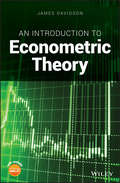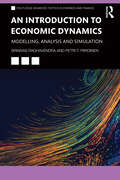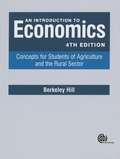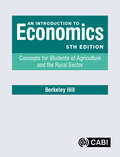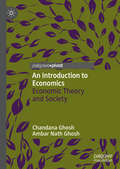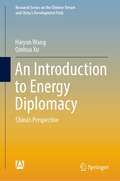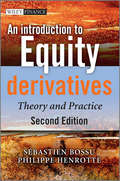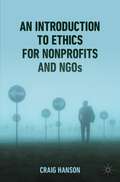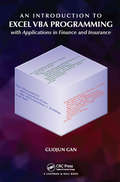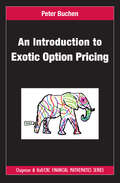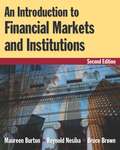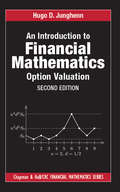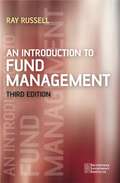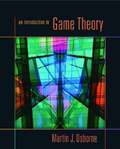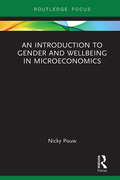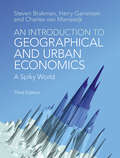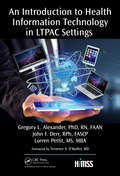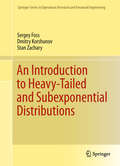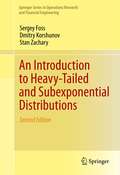- Table View
- List View
An Introduction to EU Competition Law
by Moritz Lorenz Julia DietrichSuccinct and concise, this textbook covers all the procedural and substantive aspects of EU competition law. It explores primary and secondary law through the prism of ECJ case law. Abuse of a dominant position and merger control are discussed and a separate chapter on cartels ensures the student receives the broadest possible perspective on the subject. In addition, the book's consistent structure aids understanding: section summaries underline key principles, questions reinforce learning and essay discussion topics encourage further exploration. By setting out the economic principles which underpin the subject, the author allows the student to engage with the complexity of competition law with confidence. Integrated examples and an uncluttered writing style make this required reading for all students of the subject.
An Introduction to Econometric Theory
by James DavidsonA guide to economics, statistics and finance that explores the mathematical foundations underling econometric methods An Introduction to Econometric Theory offers a text to help in the mastery of the mathematics that underlie econometric methods and includes a detailed study of matrix algebra and distribution theory. Designed to be an accessible resource, the text explains in clear language why things are being done, and how previous material informs a current argument. The style is deliberately informal with numbered theorems and lemmas avoided. However, very few technical results are quoted without some form of explanation, demonstration or proof. The author — a noted expert in the field — covers a wealth of topics including: simple regression, basic matrix algebra, the general linear model, distribution theory, the normal distribution, properties of least squares, unbiasedness and efficiency, eigenvalues, statistical inference in regression, t and F tests, the partitioned regression, specification analysis, random regressor theory, introduction to asymptotics and maximum likelihood. Each of the chapters is supplied with a collection of exercises, some of which are straightforward and others more challenging. This important text: Presents a guide for teaching econometric methods to undergraduate and graduate students of economics, statistics or finance Offers proven classroom-tested material Contains sets of exercises that accompany each chapter Includes a companion website that hosts additional materials, solution manual and lecture slides Written for undergraduates and graduate students of economics, statistics or finance, An Introduction to Econometric Theory is an essential beginner’s guide to the underpinnings of econometrics.
An Introduction to Economic Dynamics: Modelling, Analysis and Simulation (Routledge Advanced Texts in Economics and Finance)
by Srinivas Raghavendra Petri T. PiiroinenAn Introduction to Economic Dynamics provides a framework for students to appreciate and understand the basic intuition behind economic models and to experiment with those models using simulation techniques in MATLAB®. This book goes beyond the often-limited scope of other texts on economic models, which have largely focused on elucidating static equilibrium models. Comparative static analysis inhibits students from asking how the equilibrium position is achieved from an initial out-of-equilibrium position and limits their understanding of the dynamics that underlie such analysis. In this textbook, readers are introduced to ten well-established macroeconomic models – including Keynesian multiplier models, Samuelson’s multiplier and Solow’s growth model – and guided through the dynamical systems behind each model. Every chapter begins with an overview of the economic problem which the model is designed to help solve followed by an explanation of the mathematics of the model. Solutions are provided using simulation and visualisation techniques in MATLAB®, which are interwoven organically with the analysis and are introduced in a step-by-step fashion to guide the reader along the way. Appendices provide an introduction to MATLAB® along with all the necessary codes. The book is ideally suited for courses in economic dynamics, macroeconomic modelling and computational economics, as well as for students of finance, mathematics and engineering who are interested in economic models.
An Introduction to Economics
by Berkeley HillThis book provides a simple but effective introduction to economics. Fully updated and revised, this fourth edition incorporates the recent changes that have taken place in the environment in which agriculture operates. Covering the impacts of the EU expansion to 28 Member States, major changes to financial support of agriculture, financial crises, economic recession and, in many countries, high levels of unemployment, it provides a rounded and up to date introduction to the subject. The inclusion of chapter-focused exercises, essay questions and further reading suggestions make this textbook an invaluable learning tool for students of agriculture, economics and related sectors.
An Introduction to Economics: Concepts for Students of Agriculture and the Rural Sector
by Berkeley HillUpdated and revised, this fifth edition incorporates recent developments in the environment in which agriculture operates. Issues that have gained prominence since the previous edition (2014) include climate change and agriculture's mitigating role, concern with animal welfare, the social contributions that agriculture makes, risks associated with globalization, and rising concern over sustainability. Important for UK and EU readers are the adjustments needed now that the UK is no longer a member of the European Union and the nature of the national policies developed to replace the EU's Common Agricultural Policy. Containing all the major economic principles with agriculture-specific examples, An Introduction to Economics, 5th Edition provides a rounded and up-to-date introduction to the subject. The inclusion of updated chapter-focused exercises, essay questions and suggestions for further reading make this textbook an invaluable learning tool. This book: Is updated to include new developments, such as Brexit, importance of climate change and animal welfare. Includes exercises and essay questions. Suggests further reading to supplement the text. This book is recommended for students of agriculture, economics and related sectors.
An Introduction to Economics: Economic Theory and Society
by Ambar Nath Ghosh Chandana GhoshThe book compares neoclassical and Marxian economics and points out that both the schools of thought seek to analyze how a capitalist society functions. The authors show that the neoclassical economics vindicates capitalism and prescribes policies that further the interest of the rich (giant capitalists), who own most of the non-human productive resources of the economy, whereas Marxian analysis yields the result that a capitalist society is exploitative and crisis-prone. Marxian economics also suggests that the class struggle inherent in a capitalist society will eventually transform it into an equal, just and humane socialist societyThe book also presents Keynesian theory, which suggests measures that can counter at least some of the crises that Marx said a capitalist country is subject to. It discusses the current state of the capitalist world, the recent crises it was subject to and assesses the three theories in the light of these experiences. It recounts the current states of two important socialist states, namely, China and Cuba. It discusses the economic performance of Soviet Union since its birth and explains the reasons for its disintegration. It compares economic performances of the capitalist and the socialist states and assesses in the light of the experiences of these two blocs of countries which school of thought is more acceptable and closer to the truth.
An Introduction to Energy Diplomacy: China’s Perspective (Research Series on the Chinese Dream and China’s Development Path)
by Haiyun Wang Qinhua XuThis book discusses the basic and cutting-edge theories in the area of energy diplomacy in the global context, focusing on topics such as international dialogues on energy, government-directed partnerships, international energy games, the activities of international agencies, and public energy diplomacy. It also analyzes in detail the relationship between global energy diplomacy and international energy, while at the same time identifying the major problems of China’s energy diplomacy to provide a framework for the country’s energy diplomacy strategy—an essential component of China’s overall diplomatic strategy.
An Introduction to Energy Economics and Policy
by Massimo Filippini Suchita SrinivasanEnergy economics and policy are at the heart of current debates regarding climate change and the switch from fossil fuels to renewable forms of energy. They are also crucial in dealing with energy supply and security issues caused by global shocks such as the war in Ukraine. An Introduction to Energy Economics and Policy outlines pressing issues concerning current global energy systems, particularly energy production and use. It presents economic frameworks for valuating policy goals and for understanding the major energy and climate challenges faced by industrialized and developing countries. Integrating insights from behavioural economics into the standard neoclassical approach, particularly the role of behavioural anomalies, this book offers a novel introduction to energy economics and policy and provides a fresh perspective on real-world issues in energy and climate. This title is also available as open access on Cambridge Core.
An Introduction to Enterprise Architecture (Third Edition)
by Scott A. BernardAn Introduction to Enterprise Architecture is the culmination of several decades of experience that Scott A. Bernard gained through work initially as an information technology manager and then as a consultant to executives in the public and private sectors. He wrote this book for three major reasons: (1) to help move business and technology planning from a systems and process-level view to a more strategy-driven enterprise-level view, (2) to promote and explain the emerging profession of EA, and (3) to provide the first textbook on the subject of EA, which is suitable for graduate and undergraduate levels of study. To date, other books on EA have been practitioner books not specifically oriented toward a student who may be learning the subject with little to no previous exposure. Therefore, this book contains references to related academic research and industry best practices, as well as Scott A. Bernard's own observations about potential future practices and the direction of this emerging profession.
An Introduction to Equity Derivatives (Second Edition)
by Sebastien Bossu Philippe HenrotteWritten by the internationally respected academic/finance professional author team of Sebastien Bossu and Philipe Henrotte, An Introduction to Equity Derivatives is the fully updated and expanded second edition of the popular Finance and Derivatives. It covers all of the fundamentals of quantitative finance clearly and concisely without going into unnecessary technical detail. Designed for both new practitioners and students, it requires no prior background in finance and features twelve chapters of gradually increasing difficulty, beginning with basic principles of interest rate and discounting, and ending with advanced concepts in derivatives, volatility trading, and exotic products. Each chapter includes numerous illustrations and exercises accompanied by the relevant financial theory. Topics covered include present value, arbitrage pricing, portfolio theory, derivates pricing, delta-hedging, the Black-Scholes model, and more. An excellent resource for finance professionals and investors looking to acquire an understanding of financial derivatives theory and practice Completely revised and updated with new chapters, including coverage of cutting-edge concepts in volatility trading and exotic products An accompanying website is available which contains additional resources including powerpoint slides and spreadsheets. Visit www.introeqd.com for details.
An Introduction to Ethics for Nonprofits and NGOs
by Craig HansonThis textbook explores ethical issues for not-for-profit and non-governmental organizations, providing discussion-oriented cases for NFP and NGP practitioners. The book begins with an introduction to professional ethics as practiced in industry, not-for-profits and NGO’s. Attention is paid both to classical ethical theories and contemporary variants. Then, combining that theory with an introduction to the morally unique facets of the NFP and NGO landscape, it offers a series of cases which pertain to the underlying theoretical substrate. The reader will find a blend of theory and application within the text as well as guided assignment prompts. Themes covered include board relationships, staff management, work with vulnerable populations, financial transparency, Human Resources ethics and ethical dilemmas unique to international operations.
An Introduction to Excel VBA Programming: with Applications in Finance and Insurance
by Guojun GanExcel Visual Basic for Applications (VBA) can be used to automate operations in Excel and is one of the most frequently used software programs for manipulating data and building models in banks and insurance companies. An Introduction to Excel VBA Programming: with Applications in Finance and Insurance introduces readers to the basic fundamentals of VBA Programming while demonstrating applications of VBA to solve real-world problems in finance and insurance. Assuming no prior programming experience and with reproducible examples using code and data, this text is suitable for advanced undergraduate students, graduate students, actuaries, and financial analysts who wish to learn VBA. Features: Presents the theory behind the algorithms in detail Includes more than 100 exercises with selected solutions Provides VBA code in Excel files and data to reproduce the results in the book Offers a solutions manual for qualified instructors
An Introduction to Exotic Option Pricing (Chapman And Hall/crc Financial Mathematics Ser.)
by Peter BuchenIn an easy-to-understand, nontechnical yet mathematically elegant manner, An Introduction to Exotic Option Pricing shows how to price exotic options, including complex ones, without performing complicated integrations or formally solving partial differential equations (PDEs). The author incorporates much of his own unpublished work, including ideas
An Introduction to Financial Markets and Institutions
by Bruce Brown Maureen Burton Reynold F. NesibaCompletely revised and updated to include the ongoing financial crisis and the Obama administration's programs to combat it, this is the best available introductory textbook for an undergraduate course on Financial Markets and Institutions. It provides balanced coverage of theories, policies, and institutions in a conversational style that avoids complex models and mathematics, making it a student-friendly text with many unique teaching features. Financial crises, global competition, deregulation, technological innovation, and growing government oversight have significantly changed financial markets and institutions. The new edition of this text is designed to capture the ongoing changes, and to present an analytical framework that enables students to understand and anticipate changes in the financial system and accompanying changes in markets and institutions. The text includes Learning Objectives and end-of-chapter Key Words and Questions, and an online Instructor's Manual is available to adopters.
An Introduction to Financial Mathematics: Option Valuation (Chapman and Hall/CRC Financial Mathematics Series)
by Hugo D. JunghennIntroduction to Financial Mathematics: Option Valuation, Second Edition is a well-rounded primer to the mathematics and models used in the valuation of financial derivatives. The book consists of fifteen chapters, the first ten of which develop option valuation techniques in discrete time, the last five describing the theory in continuous time. The first half of the textbook develops basic finance and probability. The author then treats the binomial model as the primary example of discrete-time option valuation. The final part of the textbook examines the Black-Scholes model. The book is written to provide a straightforward account of the principles of option pricing and examines these principles in detail using standard discrete and stochastic calculus models. Additionally, the second edition has new exercises and examples, and includes many tables and graphs generated by over 30 MS Excel VBA modules available on the author’s webpage https://home.gwu.edu/~hdj/.
An Introduction to Financial Option Valuation
by Desmond J. HighamThis book is intended for use in a rigorous introductory PhD level course in econometrics, or in a field course in econometric theory. It covers the measure-theoretical foundation of probability theory, the multivariate normal distribution with its application to classical linear regression analysis, various laws of large numbers, central limit theorems and related results for independent random variables as well as for stationary time series, with applications to asymptotic inference of M-estimators, and maximum likelihood theory. Some chapters have their own appendices containing the more advanced topics and/or difficult proofs. Moreover, there are three appendices with material that is supposed to be known. Appendix I contains a comprehensive review of linear algebra, including all the proofs. Appendix II reviews a variety of mathematical topics and concepts that are used throughout the main text, and Appendix III reviews complex analysis. Therefore, this book is uniquely self-contained.
An Introduction to Fund Management
by Ray RussellAn Introduction to Fund Management introduces readers to the economic rationale for the existence of funds, the different types available, investment strategies and many other related issues from the perspective of the investment manager. It gives an overview of the whole business and explores the process and techniques of fund management, performance measurement and fund administration. This updated edition reflects new regulatory changes and industry developments.
An Introduction to Game Theory
by Martin J. OsborneAn Introduction to Game Theory, by Martin J. Osborne, presents the main principles of game theory and shows how they can be used to understand economic, social, political, and biological phenomena. The book introduces in an accessible manner the main ideas behind the theory rather than their mathematical expression. All concepts are defined precisely, and logical reasoning is used throughout. The book requires an understanding of basic mathematics but assumes no specific knowledge of economics, political science, or other social or behavioral sciences. <p><p>Coverage includes the fundamental concepts of strategic games, extensive games with perfect information, and coalitional games; the more advanced subjects of Bayesian games and extensive games with imperfect information; and the topics of repeated games, bargaining theory, evolutionary equilibrium, rationalizability, and maxminimization. The book offers a wide variety of illustrations from the social and behavioral sciences and more than 280 exercises. Each topic features examples that highlight theoretical points and illustrations that demonstrate how the theory may be used. Explaining the key concepts of game theory as simply as possible while maintaining complete precision, An Introduction to Game Theory is ideal for undergraduate and introductory graduate courses in game theory.
An Introduction to Gender and Wellbeing in Microeconomics: Foundations, Concepts and Policies
by Nicky PouwAn Introduction to Gender and Wellbeing in Microeconomics explains how to set up the basics of designing a gender-aware approach to microeconomics by constructing creative gender-aware indicators. Using a wellbeing economics framework, the book argues that economic models should take power differences such as those inherent with gender into account, and be complemented by more qualitative analysis geared to discovering the ‘how’ and ‘why’ behind the ‘what’ questions. This book will be essential reading for academic and professional researchers, as well as policy researchers in gender and economics, international development, and social and economic policy. It will be invaluable for courses relating gender to the economy, and will enable readers to get a clear and concise understanding of the gendered character of the economy and of economic policy.
An Introduction to Geographical and Urban Economics: A Spiky World
by Steven Brakman Harry Garretsen Charles van MarrewijkA comprehensive introduction to both urban and geographical economics: the two dominant approaches used to explain the distribution of economic activity across space. This fully revised and up-to-date third edition gives a full account of the ever-expanding body of knowledge and insights on urban and geographical economics, with an increased emphasis on analytical concepts and empirical methods, reflecting developments in the literature since the last edition. The authors provide both state-of-the-art theories and empirics, introducing new data, methods and models for this edition, including a whole chapter dedicated to measurement issues and empirical methods. Written in a style that is accessible to students who are new to the field, this textbook also includes more advanced concepts that will interest experienced researchers. Unrivalled in its scope and depth, this title is perfect for readers seeking to understand the uneven spatial distribution of economic activity between and within countries.
An Introduction to Health Information Technology in LTPAC Settings (HIMSS Book Series)
by Gregory L. Alexander, PhD, RN, FAAN Derr F. John, RPh, FASCP Lorren Pettit, MS, MBAA multiplicity of factors converging together suggest the long term/post-acute care (LTPAC) provider community (e.g. nursing homes, behavioral health facilities, home health agencies, etc.) will accelerate in importance within the healthcare ecosystem during the next few years. The challenge for many LTPAC providers in this emerging environment will be to advance their clinical health information technologies (health IT) capabilities in order to "play" with other providers in the healthcare "sandbox." This book is designed to assist LTPAC leaders in identifying and exploring the array of critical issues one needs to consider in order to operate within an advanced clinical health IT ecosystem. This book surveys key issues surrounding the use of clinical health IT in LTPAC settings, to include providing readers with a suggested strategic plan and roadmap for selecting and installing digital health technologies in LTPAC organizations. Though the focus of the book primarily centers on the U.S. LTPAC provider’s experience, the authors also spend time addressing global and future LTPAC considerations.
An Introduction to Heavy-Tailed and Subexponential Distributions (Springer Series in Operations Research and Financial Engineering #38)
by Dmitry Korshunov Stan Zachary Sergey FossHeavy-tailed probability distributions are an important component in the modeling of many stochastic systems. They are frequently used to accurately model inputs and outputs of computer and data networks and service facilities such as call centers. They are an essential for describing risk processes in finance and also for insurance premia pricing, and such distributions occur naturally in models of epidemiological spread. The class includes distributions with power law tails such as the Pareto, as well as the lognormal and certain Weibull distributions.<P><P> This monograph defines the classes of long-tailed and subexponential distributions in one dimension and provides a complete and comprehensive description of their properties. New results are presented in a simple, coherent and systematic way. This leads to a comprehensive exposition of tail properties of sums of independent random variables whose distributions belong to the long-tailed and subexponential class.<P> The book includes a discussion of and references to contemporary areas of applications and also contains preliminary mathematical material which makes the book self contained. Modelers in the fields of finance, insurance, network science and environmental studies will find this book to be an essential reference.
An Introduction to Heavy-Tailed and Subexponential Distributions, 2nd Edition (Springer Series in Operations Research and Financial Engineering)
by Dmitry Korshunov Stan Zachary Sergey FossHeavy-tailed probability distributions are an important component in the modeling of many stochastic systems. They are frequently used to accurately model inputs and outputs of computer and data networks and service facilities such as call centers. They are an essential for describing risk processes in finance and also for insurance premia pricing, and such distributions occur naturally in models of epidemiological spread. The class includes distributions with power law tails such as the Pareto, as well as the lognormal and certain Weibull distributions.<P><P> One of the highlights of this new edition is that it includes problems at the end of each chapter. Chapter 5 is also updated to include interesting applications to queueing theory, risk, and branching processes. New results are presented in a simple, coherent and systematic way.<P> Graduate students as well as modelers in the fields of finance, insurance, network science and environmental studies will find this book to be an essential reference.
An Introduction to Human Resource Management
by Dr Nick WiltonThe second edition of Nick Wilton's An Introduction to Human Resource Management continues to provide an engaging and holistic overview of the role of Human Resource Management in its contemporary context. It reflects on current trends, the labour market and the global economy while offering a critical yet accessible treatment of both theoretical and practical issues relating to Human Resource Management. <P><P> * New Full Colour Layout makes the text easy to read and navigate <P> * HR in Practice boxes illustrate how theory can be applied in practice <P> * Ethical Insights present ethical considerations for budding practitioners<P> * Global Insights highlight practices around the world <P> * Research Insights invite you to explore academic research <P> * Case Studies relate theory to real organisations such as Tesco, Intel and Lloyds TSB <P> * Self-test questions are ideal for revision <P> * Further Online Reading provides free access to scholarly journal articles <P> * Glossary and Definitions explain key terms <P> * Podcasts summarise key topics and highlight employability skills <P> Visit: www.sagepub.co.uk/wilton2 to access additional learning resources including extended case studies, chapter summaries, podcasts and journal articles.<P> This book is essential reading for undergraduate, postgraduate and MBA students, including those studying for their CIPD qualifications.
An Introduction to Human Resource Management
by John StredwickSince its original publication in 2000, this text has been intended for students studying HRM for the first time. Its major features are its comprehensive and wide-ranging nature which deals with all major aspects of HRM in a down to earth and practical way, alongside the necessary theoretical underpinning. The key strength is its accessibility to students new to the subject area where it combines a clear explanation with numerous relevant and interesting cases and comments. The range and nature of HRM is fully illustrated by a combination of real life and fictional case studies which heighten awareness of key issues involved in HRM today. This new edition will continue to be appropriate for undergraduate courses, especially first and second year students studying an HRM degree but also for post-graduate courses where many students are new to the field of HRM. It continues to be divided into 12 chapters to provide one topic a week on a modular course, but it may be extended into two semesters. It has been revised to place a greater emphasis on the role of human resources in improving organisational and employee performance. These revisions include the greater use of technology in resourcing and development areas, the change of emphasis from ‘recruitment/selection’ to ‘talent management’ and the use of social networking developments as an aid to HR management. Recent legal developments will also be covered including those relating to age discrimination and the regulation of agency workers. It will be supported by a supplement for tutors and additional web-based cases and other materials for tutors and students.

